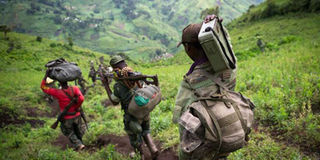DR Congo blames shadowy rebel group for wave of massacres

M23 rebels leave their position in the village of Karuba, eastern Democratic Republic of Congo, on November 30, 2012. DR Congo blames shadowy rebel group for a two-year wave of massacres in a restive corner of DR Congo centres. PHOTO | PHIL MOORE | AFP
What you need to know:
- Secrecy shrouds the group, which is dominated by hardline Ugandan Muslims who were initially focused on overthrowing Uganda’s Yoweri Museveni.
- More than two years on, the government and UN have been unable to protect civilians from the attacks.
- The Allied Democratic Forces has not claimed any of the massacres, and no experts on DR Congo have found a link between the group and the global jihadist underground.
BENI, DR Congo
The official explanation for a two-year wave of massacres in a restive corner of DR Congo centres on a shadowy rebel group accused of having ties to the global jihadist underground.
But some basic details about the alleged killers of more than 700 victims — the latest over the Christmas weekend — haven’t quite convinced observers and experts.
The truth, they say, is more complicated and may lead all the way to the halls of power in the vast, mineral-rich and unstable central African nation.
UN experts, referring to the claimed jihadist links in past reports, have simply stated: “There is no proof of this allegation.”
But that has not stopped the Democratic Republic of Congo’s leadership and the UN peacekeeping mission Monusco from blaming the bloodbath around the town of Beni, in the country’s strife-torn northeast, on the Allied Democratic Forces (ADF).
Secrecy shrouds the group, which is dominated by hardline Ugandan Muslims who were initially focused on overthrowing Uganda’s Yoweri Museveni.
The group went on to absorb other rebel factions and started carrying out attacks in 1995. Gradually pushed westwards by the Ugandan army, the ADF relocated most of its activities to DR Congo.
When the Beni massacres started in October 2014, with most of the victims hacked to death, the ADF was quickly branded the culprit by both Congolese authorities and Monusco.
PROTECT CIVILIANS
More than two years on, the government and UN have been unable to protect civilians from the attacks, and the ADF remains the only official explanation — with Kinshasa insisting on a jihadist link to the killings.
Many ADF recruits — who were drawn this year from Tanzania, Burundi, Kenya and as far as Somalia — were not hardcore ideologues but young Muslims lured by the promise of going to study in Saudi Arabia, an intelligence agent and civil society source told AFP.
Meanwhile, the ADF has not claimed any of the massacres, and no experts on DR Congo have found a link between the group and the global jihadist underground.
Others have gone further, alleging government agents have a role in the killing.
A group run by US researcher Jason Stearns published a report in March claiming several distinct groups “appear to be involved in the massacres”, including soldiers from the regular army.
The government rejected the claims and said the ADF was “definitely” responsible. Stearns was expelled from DR Congo after the report’s release.
In explaining the violence, some have cited struggles for control of trafficking in various industries like timber, agricultural produce or minerals in a region with extremely rich potential.





